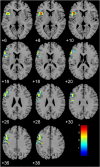Childhood stress, serotonin transporter gene and brain structures in major depression
- PMID: 20147891
- PMCID: PMC3055341
- DOI: 10.1038/npp.2010.8
Childhood stress, serotonin transporter gene and brain structures in major depression
Abstract
The underlying neurobiology of major depression (MD) is likely to represent an interaction between genetic susceptibility and environmental factors such as stress. We investigated, in a multimodal high-resolution magnetic resonance imaging (MRI) genetic study, whether reduced hippocampal volumes and other brain alterations are associated with the tri-allelic polymorphism of the serotonin transporter and childhood stress in patients with MD and healthy subjects. Patients with MD and healthy participants were investigated using high-resolution MRI and genotyping for serotonin transporter polymorphism in the promoter region of the serotonin transporter gene (SLC6A4, 5-HTTLPR). Region of interest analysis of the hippocampus, whole-brain voxel-based morphometry (VBM), and assessment of childhood stress were carried out. Patients carrying the risk S-allele developed smaller hippocampal volumes when they had a history of emotional neglect compared with patients who only had one risk factor (environmental or genetic). In patients, childhood stress also predicted further hippocampal white matter alterations independently from the genotype. Moreover, the left prefrontal cortex was smaller in patients, whereby childhood stress resulted in larger prefrontal volumes in those subjects carrying the non-risk L-allele, suggesting preventive effects. The findings indicate that subjects with both environmental and genetic risk factors are susceptible to stress-related hippocampal changes. Structural brain changes due to stress represent part of the mechanism by which the illness risk and outcome might be genetically mediated.
Figures



Similar articles
-
DNA methylation of the serotonin transporter gene in peripheral cells and stress-related changes in hippocampal volume: a study in depressed patients and healthy controls.PLoS One. 2015 Mar 17;10(3):e0119061. doi: 10.1371/journal.pone.0119061. eCollection 2015. PLoS One. 2015. PMID: 25781010 Free PMC article.
-
Interaction of childhood stress with hippocampus and prefrontal cortex volume reduction in major depression.J Psychiatr Res. 2010 Oct;44(13):799-807. doi: 10.1016/j.jpsychires.2010.01.006. Epub 2010 Feb 1. J Psychiatr Res. 2010. PMID: 20122698
-
Reduced gray matter brain volumes are associated with variants of the serotonin transporter gene in major depression.Mol Psychiatry. 2008 Dec;13(12):1093-101. doi: 10.1038/mp.2008.62. Epub 2008 Jul 1. Mol Psychiatry. 2008. PMID: 19008895
-
Neuroimaging genetics: new perspectives in research on major depression?Acta Psychiatr Scand. 2008 Nov;118(5):363-72. doi: 10.1111/j.1600-0447.2008.01225.x. Epub 2008 Jul 14. Acta Psychiatr Scand. 2008. PMID: 18644006 Review.
-
[Posttraumatic stress disorder (PTSD) as a consequence of the interaction between an individual genetic susceptibility, a traumatogenic event and a social context].Encephale. 2012 Oct;38(5):373-80. doi: 10.1016/j.encep.2011.12.003. Epub 2012 Jan 24. Encephale. 2012. PMID: 23062450 Review. French.
Cited by
-
DNA methylation of the serotonin transporter gene in peripheral cells and stress-related changes in hippocampal volume: a study in depressed patients and healthy controls.PLoS One. 2015 Mar 17;10(3):e0119061. doi: 10.1371/journal.pone.0119061. eCollection 2015. PLoS One. 2015. PMID: 25781010 Free PMC article.
-
Looking Beyond the 5-HTTLPR Polymorphism: Genetic and Epigenetic Layers of Regulation Affecting the Serotonin Transporter Gene Expression.Mol Neurobiol. 2017 Dec;54(10):8386-8403. doi: 10.1007/s12035-016-0304-6. Epub 2016 Dec 8. Mol Neurobiol. 2017. PMID: 27933583 Review.
-
Childhood adversity, stress reactivity, and structural brain measures in stress-related/neurodevelopmental disorders, and their comorbidity: A large transdiagnostic cross-sectional study.Hum Brain Mapp. 2024 Oct;45(14):e70025. doi: 10.1002/hbm.70025. Hum Brain Mapp. 2024. PMID: 39394915 Free PMC article.
-
The hippocampus, neurotrophic factors and depression: possible implications for the pharmacotherapy of depression.CNS Drugs. 2011 Nov 1;25(11):913-31. doi: 10.2165/11595900-000000000-00000. CNS Drugs. 2011. PMID: 22054117 Review.
-
No effect of 5HTTLPR or BDNF Val66Met polymorphism on hippocampal morphology in major depression.Genes Brain Behav. 2011 Oct;10(7):756-64. doi: 10.1111/j.1601-183X.2011.00714.x. Epub 2011 Jul 12. Genes Brain Behav. 2011. PMID: 21692988 Free PMC article.
References
-
- Andreasen NC, Cohen G, Harris G, Cizadlo T, Parkkinen J, Rezai K, et al. Image processing for the study of brain structure and function: problems and programs. J Neuropsychiatry Clin Neurosci. 1992;4:125–133. - PubMed
-
- Ashburner J, Friston KJ. Unified segmentation. Neuroimage. 2005;26:839–851. - PubMed
-
- Bengel D, Murphy DL, Andrews AM, Wichems CH, Feltner D, Heils A, et al. Altered brain serotonin homeostasis and locomotor insensitivity to 3, 4-methylenedioxymethamphetamine (‘Ecstasy') in serotonin transporter-deficient mice. Mol Pharmacol. 1998;53:649–655. - PubMed
-
- Bernstein DP, Fink L, Handelsman L, Foote J, Lovejoy M, Wenzel K, et al. Initial reliability and validity of a new retrospective measure of child abuse and neglect. Am J Psychiatry. 1994;151:1132–1136. - PubMed
-
- Bernstein DP, Stein JA, Newcomb MD, Walker E, Pogge D, Ahluvalia T, et al. Development and validation of a brief screening version of the Childhood Trauma Questionnaire. Child Abuse Negl. 2003;27:169–190. - PubMed
Publication types
MeSH terms
Substances
LinkOut - more resources
Full Text Sources
Medical

